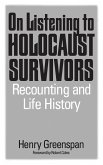- Broschiertes Buch
- Merkliste
- Auf die Merkliste
- Bewerten Bewerten
- Teilen
- Produkt teilen
- Produkterinnerung
- Produkterinnerung
This book explains how managers and co-workers can help foster-and not hinder-the process of emotional recovery for employees who have been traumatized and are returning to work.
Andere Kunden interessierten sich auch für
![Cognitive-Behavioral Treatment for Adult Survivors of Childhood Trauma Cognitive-Behavioral Treatment for Adult Survivors of Childhood Trauma]() Mervin R. SmuckerCognitive-Behavioral Treatment for Adult Survivors of Childhood Trauma110,99 €
Mervin R. SmuckerCognitive-Behavioral Treatment for Adult Survivors of Childhood Trauma110,99 €![Analysis of the Incest Trauma Analysis of the Incest Trauma]() Susan A. KlettAnalysis of the Incest Trauma149,99 €
Susan A. KlettAnalysis of the Incest Trauma149,99 €![Return Return]() Marcus FarrisReturn53,99 €
Marcus FarrisReturn53,99 €![Compassion Fatigue Compassion Fatigue]() Charles R. FigleyCompassion Fatigue104,99 €
Charles R. FigleyCompassion Fatigue104,99 €![On Listening to Holocaust Survivors On Listening to Holocaust Survivors]() Henry GreenspanOn Listening to Holocaust Survivors87,99 €
Henry GreenspanOn Listening to Holocaust Survivors87,99 €![Beyond the Veil Beyond the Veil]() Kennedy AllenBeyond the Veil13,99 €
Kennedy AllenBeyond the Veil13,99 €![Return Return]() Marcus FarrisReturn56,99 €
Marcus FarrisReturn56,99 €-
-
-
This book explains how managers and co-workers can help foster-and not hinder-the process of emotional recovery for employees who have been traumatized and are returning to work.
Produktdetails
- Produktdetails
- Verlag: University Press of America
- Seitenzahl: 182
- Erscheinungstermin: 27. April 2010
- Englisch
- Abmessung: 229mm x 152mm x 10mm
- Gewicht: 273g
- ISBN-13: 9780761850304
- ISBN-10: 0761850309
- Artikelnr.: 29985792
- Herstellerkennzeichnung
- Libri GmbH
- Europaallee 1
- 36244 Bad Hersfeld
- gpsr@libri.de
- Verlag: University Press of America
- Seitenzahl: 182
- Erscheinungstermin: 27. April 2010
- Englisch
- Abmessung: 229mm x 152mm x 10mm
- Gewicht: 273g
- ISBN-13: 9780761850304
- ISBN-10: 0761850309
- Artikelnr.: 29985792
- Herstellerkennzeichnung
- Libri GmbH
- Europaallee 1
- 36244 Bad Hersfeld
- gpsr@libri.de
Barbara Barski-Carrow earned her doctorate in adult education and human resources from Virginia Tech and is principal of Carrow Associates. Her work focuses on professional relationships, helping managers and employees relate better when individuals return to work after a traumatic life event. Through more than thirty years of experience in the field, she has created educational forums for senior management in both the public and private sectors.
Chapter 1 Acknowledgments
Chapter 2 Introduction
Part 3 Part I. Understanding the Traumatic Life Experience (TLE)
Chapter 4 Chapter 1. Why I Wrote This Book
Chapter 5 Chapter 2. What is a Traumatic Life Experience (TLE)?
Chapter 6 Chapter 3. What is it Like to Be a Returning TLE Employee?
Chapter 7 Chapter 4. What Can Managers Do?
Chapter 8 Chapter 5. What Do You Tell Co-Workers?
Chapter 9 Chapter 6. What Does Psychology Tell Us About Trauma?
Chapter 10 Chapter 7. What Can An Employee Assistance Program Do?
Part 11 Part II. Taking Practical Steps
Chapter 12 Chapter 8. What is a Study Circle?
Chapter 13 Chapter 9. How Does an Organization Set Up a Study Circle?
Chapter 14 Chapter 10. Putting Out a Welcome Mat: The First Study Circle
Chapter 15 Chapter 11. Lending a Listening Ear: The Second Study Circle
Chapter 16 Chapter 12. Offering a Helping Hand: The Third Study Circle
Part 17 Part III. Some Special Circumstances
Chapter 18 Chapter 13. When an Entire Group is Traumatized, How Do Managers
and Employees Cope?
Chapter 19 Chapter 14. How Does an Employee's Trauma Affect His Children?
Chapter 20 Chapter 15. How Can You Help Yourself After a Traumatic Life
Experience?
Chapter 21 Chapter 16. What Challenges Face a Facilitator?
Chapter 22 Appendix: Study Circle Handouts
Chapter 23 References
Chapter 2 Introduction
Part 3 Part I. Understanding the Traumatic Life Experience (TLE)
Chapter 4 Chapter 1. Why I Wrote This Book
Chapter 5 Chapter 2. What is a Traumatic Life Experience (TLE)?
Chapter 6 Chapter 3. What is it Like to Be a Returning TLE Employee?
Chapter 7 Chapter 4. What Can Managers Do?
Chapter 8 Chapter 5. What Do You Tell Co-Workers?
Chapter 9 Chapter 6. What Does Psychology Tell Us About Trauma?
Chapter 10 Chapter 7. What Can An Employee Assistance Program Do?
Part 11 Part II. Taking Practical Steps
Chapter 12 Chapter 8. What is a Study Circle?
Chapter 13 Chapter 9. How Does an Organization Set Up a Study Circle?
Chapter 14 Chapter 10. Putting Out a Welcome Mat: The First Study Circle
Chapter 15 Chapter 11. Lending a Listening Ear: The Second Study Circle
Chapter 16 Chapter 12. Offering a Helping Hand: The Third Study Circle
Part 17 Part III. Some Special Circumstances
Chapter 18 Chapter 13. When an Entire Group is Traumatized, How Do Managers
and Employees Cope?
Chapter 19 Chapter 14. How Does an Employee's Trauma Affect His Children?
Chapter 20 Chapter 15. How Can You Help Yourself After a Traumatic Life
Experience?
Chapter 21 Chapter 16. What Challenges Face a Facilitator?
Chapter 22 Appendix: Study Circle Handouts
Chapter 23 References
Chapter 1 Acknowledgments
Chapter 2 Introduction
Part 3 Part I. Understanding the Traumatic Life Experience (TLE)
Chapter 4 Chapter 1. Why I Wrote This Book
Chapter 5 Chapter 2. What is a Traumatic Life Experience (TLE)?
Chapter 6 Chapter 3. What is it Like to Be a Returning TLE Employee?
Chapter 7 Chapter 4. What Can Managers Do?
Chapter 8 Chapter 5. What Do You Tell Co-Workers?
Chapter 9 Chapter 6. What Does Psychology Tell Us About Trauma?
Chapter 10 Chapter 7. What Can An Employee Assistance Program Do?
Part 11 Part II. Taking Practical Steps
Chapter 12 Chapter 8. What is a Study Circle?
Chapter 13 Chapter 9. How Does an Organization Set Up a Study Circle?
Chapter 14 Chapter 10. Putting Out a Welcome Mat: The First Study Circle
Chapter 15 Chapter 11. Lending a Listening Ear: The Second Study Circle
Chapter 16 Chapter 12. Offering a Helping Hand: The Third Study Circle
Part 17 Part III. Some Special Circumstances
Chapter 18 Chapter 13. When an Entire Group is Traumatized, How Do Managers
and Employees Cope?
Chapter 19 Chapter 14. How Does an Employee's Trauma Affect His Children?
Chapter 20 Chapter 15. How Can You Help Yourself After a Traumatic Life
Experience?
Chapter 21 Chapter 16. What Challenges Face a Facilitator?
Chapter 22 Appendix: Study Circle Handouts
Chapter 23 References
Chapter 2 Introduction
Part 3 Part I. Understanding the Traumatic Life Experience (TLE)
Chapter 4 Chapter 1. Why I Wrote This Book
Chapter 5 Chapter 2. What is a Traumatic Life Experience (TLE)?
Chapter 6 Chapter 3. What is it Like to Be a Returning TLE Employee?
Chapter 7 Chapter 4. What Can Managers Do?
Chapter 8 Chapter 5. What Do You Tell Co-Workers?
Chapter 9 Chapter 6. What Does Psychology Tell Us About Trauma?
Chapter 10 Chapter 7. What Can An Employee Assistance Program Do?
Part 11 Part II. Taking Practical Steps
Chapter 12 Chapter 8. What is a Study Circle?
Chapter 13 Chapter 9. How Does an Organization Set Up a Study Circle?
Chapter 14 Chapter 10. Putting Out a Welcome Mat: The First Study Circle
Chapter 15 Chapter 11. Lending a Listening Ear: The Second Study Circle
Chapter 16 Chapter 12. Offering a Helping Hand: The Third Study Circle
Part 17 Part III. Some Special Circumstances
Chapter 18 Chapter 13. When an Entire Group is Traumatized, How Do Managers
and Employees Cope?
Chapter 19 Chapter 14. How Does an Employee's Trauma Affect His Children?
Chapter 20 Chapter 15. How Can You Help Yourself After a Traumatic Life
Experience?
Chapter 21 Chapter 16. What Challenges Face a Facilitator?
Chapter 22 Appendix: Study Circle Handouts
Chapter 23 References









